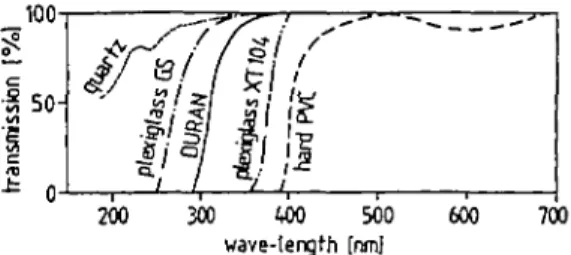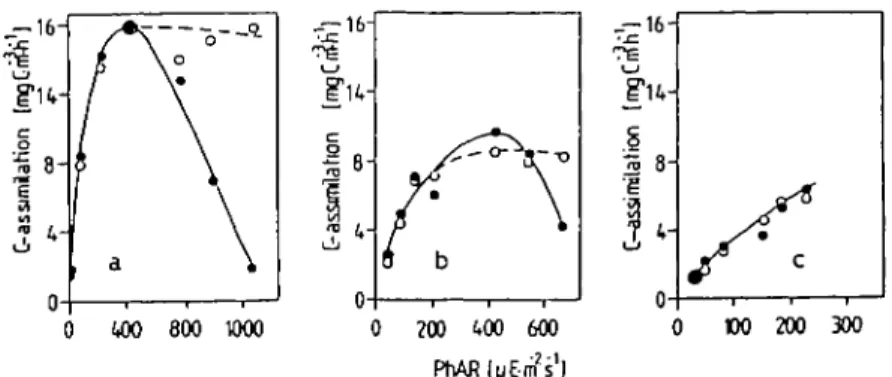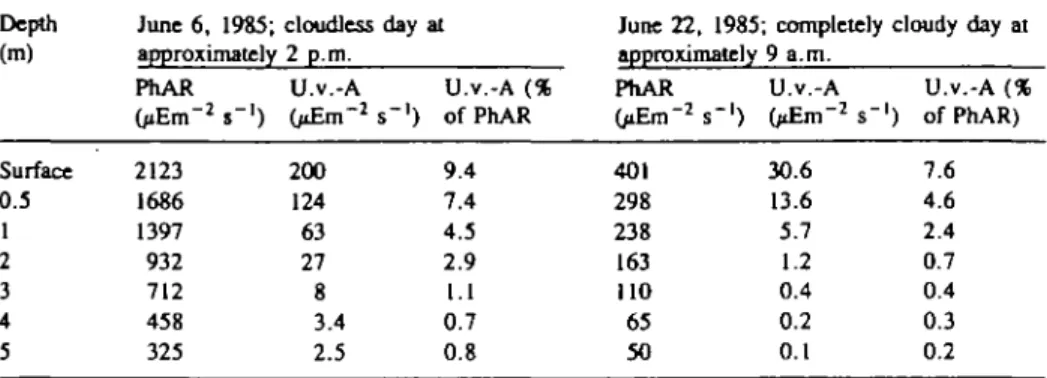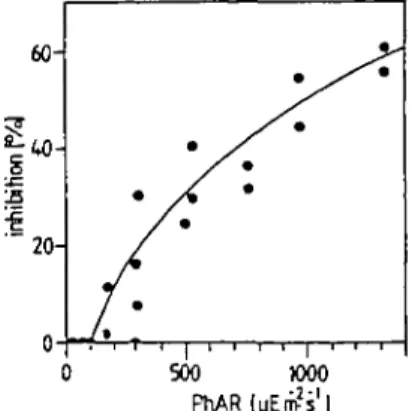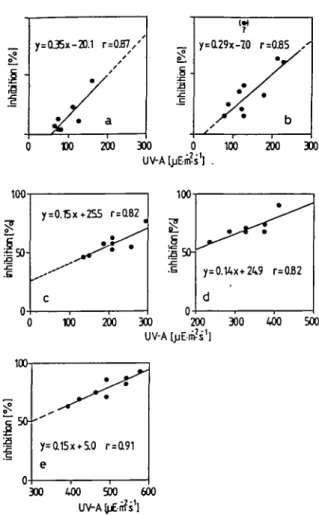Journal of Plankton Research Vol.9 no.5 pp.935-943, 1987
The influence of longwave ultraviolet radiation (u.v.-A) on
the photosynthetic activity (
14C-assimilation) of
phytoplankton
B.Buhlmann, P.Bossard1 and U.Uehlinger
Institute of Aquatic Sciences (EAWAG), Swiss Federal Institute of Technology (ETH). CH-8600 DQbendorf, Switzerland
'To whom correspondence should be addressed at: Lake Research Laboratory EAWAG/ETH, CH-6047 Kastanienbaum, Switzerland
Abstract. The impact of u.v.-A (315—400 nm) on phytoplanktonic C-assimilation has been studied in situ
and in the laboratory under artificial light. Water samples from Lake Lucerne were placed in DURAN-glass bottles and incubated either covered or uncovered with u.v. absorbing transparent tubes. Exposure to u.v.-A clearly inhibited '^C-assimilation in the uncovered samples both in situ and in the laboratory. Variations in visible light intensity and filtering of u.v.-B selectively demonstrated small inhibition of '^-assimilation. U.v.-A inhibition of productivity is the major factor in the well known depression in productivity for surface waters.
Introduction
Phytoplankton incubated in bottles at different depths of a lake often show a marked decrease in 14C-assimilation close to the surface. This phenomenon is most apparent
at noon, when light intensities are highest. Many authors have indicated that this decrease in photosynthetic rate is a light-induced effect (see literature review by Harris, f978), and is therefore called 'photoinhibition'. There are, however, controversial issues on the causes of photoinhibition, especially as to the influences of light quality and u.v.-radiation. Vollenweider and Nauwerck (1961) attribute photoinhibition to high inten-sities of the visible light spectrum, while Elster (1965), Jitts et al. (1976), and Jokiel and York (1984) stress the importance of u.v.-radiation. McLeod and McLachlan (1959) and Arnold (1933) showed that u.v.-radiation at a wavelength of 253.7 nm (u.v.-C) applied to algae before incubation with visible light, causes a reduction in photosyn-thesis. However, since u.v.-C does not reach the lake surface, its influence on photo-inhibition is not of ecological importance. According to Findenegg (1966), Worrest
etal. (1980), Hillman (1975), Halldal (1967) and Maske (1984), u.v.-B (280-315 nm)
is capable of causing photoinhibition. Jokiel and York (1984) demonstrated growth in-hibition primarily due to u.v.-B with some effect of u.v.-A (315-400 nm). Maske (1984) demonstrated carbon uptake inhibition primarily due to u.v.-A; conversely Bell and • Merinova (1961), and Halldal (1967) attribute no photoinhibitory effect to u.v.-A.
U.v. and visible radiation affect C assimilation at several levels. One level is the action spectra of the chlorophylls (Halldal, 1967; Bell and Merinova, 1961); another effect is at the level of physiological mechanisms (Harris, 1978), and finally there are environmental factors. This investigation was intended to evaluate the impacts of u.v.-radiation and of visible light (PhAR) in natural environments on photoinhibition of phytoplankton primary production with special regard to the l4C-assimilation technique
wave-length [rani
Fig. 1. Transmission characteristics of different materials measured in a spectrophotomaer with a Deuterium lamp at wavelengths <350 nm, and with a Wolfram lamp >350 nm.
Methods
The relationship between photosynthesis (P) and irradiance (I), the P/I-curve, was measured in phytoplankton using the 14C-assimilation technique on samples from Horw
Bay, a basin of mesotrophic Lake Lucerne (430 m above sea level), taken from a depth of 2.5 m, transferred into 100-ml DURAN or quartz bottles (for transmission characteristics, see Figure 1) and incubated for 4 h, from 10 a.m. to 2 p.m., either suspended at different depths in the lake or in light and temperature controlled laboratory incubators.
After incubation, the 14C-samples were processed by the acid bubbling method,
ac-cording to Gachter and Mares (1978).
To investigate the impact of u.v.-A on 14C-assimilation, the DURAN bottles could
be covered with transparent hard PVC tubes (for transmission characteristics see Figure 1). Photoinhibition (INH) in a non-covered bottle is defined as:
100 (i)
where A = 14C-assimilation in the uncovered bottle; A^^ = l4C-assimilation in the
covered bottle; / = incident PhAR-intensity.
Laboratory incubations were carried out in incubators similar to those of Fee (1973). The front windows were transparent to u.v.-A and u.v.-B (see Figure 1, Plexiglas, GS-type, manufactured by Rohm GmbH, Darmstadt, FRG). High-pressure metal halide gas-discharge lamps (HPI400 W, made by Philips Company), and high-pressure mer-cury vapor fluorescent reflector lamps (HPL-R, 700 W, made by Philips) furnished the photosynthetic active radiation (PhAR) through the front window, whereas tubular low-pressure mercury-vapor fluorescent lamps (TL 20 or 40 W, colour/09N, made by Philips) emitted u.v.-A (315-400 nm, emission maximum at 350 nm, Figure 2) either from the front or from above. Since the HPL-R and HPI-lamps also emitted some u.v.-A radiation (Figure 2) u.v.-absorbing frontscreens (Plexiglas XT) were used il u.v.-A-radiation was not desired.
During incubations in the lake, PhAR was continuously monitored on the roof ol the Lake Research Laboratory, 2 km from the sampling site, using a quantum sensoi (LI 190) and a printing integrator (LI 550), both made by LI-COR Inc., Lincoln, NE, USA. The printing integrator yielded a continuous output of PhAR-integrals over in-tervals of 10 min. The vertical distribution of PhAR in the lake water body was measured
The influence of u.v.-A on photosynthesis
20-1
oiio-t
a. o-n bu
300 400 500 600 700 wave-length Inm] 300 W0 500 600 700 wave-length [nm| 300 W0 500 600 700 wave-length [nmj Fig. 2. Absolute spectra) power distribution of artificial light sources (according to the specifications of the producer), (a) U.v.-A: tabular low-pressure mercury-vapor fluorescent lamp (TL 20 W, colour/09N, Philips); (b) high-pressure metal halide gas-discharge lamp (HPI 400 W, Philips); (c) high-pressure mer-cury vapor fluorescent reflector lamp (HPL-R 700 W, Philips).with a scalar quantum sensor (LI 190 SB) and an integrating quantum meter (LI 188) made by LI-COR Inc. A second device served as a reference, measuring PhAR above the water surface. The same type of instrument was used for measurements above and below the water surface. U.v.-radiation was measured by a selenium photoelement, type GQ, made by Electrocell-Gesellschaft M.B.H., Falkenthal and Presser, Berlin, FRG. The window of the radiation spectrum was defined by filters of the type UG 1 (transmission 330-390 nm), made by Schott, Mainz, FRG. The sensors were calibrated with a 450 W Xenon lamp, a monochromator device, and a calibrated pyrometer at the Swiss Federal Institute of Technology (ETH) in Zurich (Institut fur FestkSrperphy sik).
Total inorganic carbon was determined according to Rhode (1958). Chlorophyll a was analyzed according to SCOR/UNESCO (1969).
Results and Discussion
Influence of u.v.-radiation on in situ I4C-assimilation
In June 1985 various incubations of Horw Bay samples, taken from 2.5 m depth, were carried out at different weather conditions. The DURAN bottles were incubated in a horizontal position pairwise in different depths between the surface and 10 m and therefore exposed to different light intensities. One bottle of each pair was covered with a transparent hard PVC tube which absorbs all u.v.-radiation <390 nm wavelength and therefore prevents it from penetrating the sample. Figure 3 shows typical P/I-curves at different weather conditions from bright sunshine to completely overcast. The samples exposed to u.v.-radiation exhibited a marked decrease in C-assimilation at PhAR-intensities above —500 /tEirT2 s~', while the samples excluded from exposure to u.v.
did not show any inhibitory effect. From these and numerous similar results we con-clude that solar radiation between 300 and 400 nm wavelength must cause photoinhibi-tion. Since the DURAN glass bottles prevent the penetration of u.v.-radiation < 300 nm, the effect must be limited mainly to u.v.-A. The results also demonstrate that photoinhibi-tion is not limited to cloudless days; however, a minimum intensity of solar radiaphotoinhibi-tion is necessary to induce photoinhibition (Figure 3c). In Lake Lucerne, photoinhibition
MX) 800 WOO 0 200 MX) 600 PhAfl I
0 WO 200 300
Fig. 3. l4C-Assimilation of phytoplankton (P/I curves): incubations in Horw Bay (Lake Lucerne) with and without the influence of u.v.-A. (a) Cloudless; (b) Cloudy; (c) overcast. • • DURAN bottles, O O DURAN bottles covered with hard p. v.c. Chlorophyll a concentration of sample a: 4.37 mg m~3, b: 3.97 mg m~3, c: 2.52 mg m~3.
0 200 WM 600 800 1000 PhAfi
0 200 W0 600 800 1000
Fig. 4. Comparison between MC-assimilation rates measured in • • DURAN and in O O quartz bottles incubated in Horw Bay. Chlorophyll a concentration of sample a: 5.66 mg ra , b: 4.33 mg
has been observed as deep as 2—3 m from the surface, and may therefore affect a substantial part of the photosynthetically active phytoplankton.
To determine the contribution of u.v.-A and u.v.-B to photoinhibition, similar in
situ experiments with quartz and DURAN bottles were performed. At higher light
in-tensities, the two bottle types yield approximately the same assimilation rates (Figure 4). At lower light intensities, however, quartz may permit slightly higher C-assimilation. This result corresponds to the observations of Findenegg (1966), Worrest et al. (1980), Hillman (1975), Umavirta and Hakala (1972). Experiments in marine environments from Lorenzen (1979) on a sunny day in August at latitudes comparable to central Europe demonstrated that exclusion of u.v.-B would increase carbon uptake near the surface by 1.1—2 times. The authors concluded however, that the effect of u.v.-B on present day estimates of oceanic production is minimal. A relatively insignificant role of u.v.-B is to be expected in view of the small amounts of u.v.-u.v.-B reaching the lake surface (Bener, 1963) and of the high absorption capacity of water for u.v.-B (Tyler and Smith, 1970; Baker and Smith, 1982). Therefore, our experiments support the conclusion that naturally occurring u.v.-B does not enhance photoinhibition significantly when super-imposed to the naturally occurring u.v.-A effect.
The influence of u.v.-A on photosynthesis Table I. Vertical profiles for u.v.-A- and PhAR-irradiances
in % of PhAR of the same Depth (m) Surface 0.5 1 2 3 4 5 June 6, 1985; approximately PhAR OiEm"2 s"1) 2123 1686 1397 932 712 458 325 depth. cloudless 2 p.m. U.v.-A OiErn"2 200 124 63 27 8 3.4 2.5 day at U.v.-A (% s"1) of PhAR 9.4 7.4 4.5 2.9 1.1 0.7 0.8
in Horw Bay (in pEm s ')
June 22, 1985: approximately PhAR OiEm"2 s"1) 401 298 238 163 110 65 50 ; completely 9 a.m. U.v.-A <j£m-2 s"1 30.6 13.6 5.7 1.2 0.4 0.2 0.1
, and for u.v.-A
cloudy day at U.v.-A (% ) of PhAR) 7.6 4.6 2.4 0.7 0.4 0.3 0.2
U.v.-A radiation in situ
Table I shows a typical vertical profile for u.v.-A (filter UG1: 330-390 run) and PhAR (400 — 700 nm) in Horw Bay measured (i) on a cloudless day at approximately 2 p.m. and (ii) on a completely cloudy day at approximately 9 a.m. only 8 days apart from each other. The results show that the u.v.-A radiation at the water surface varies substan-tially from -200—31 /xEm~2 s"1 with corresponding intensities of 63—5.7 ^Em~2
s~' at a depth of 1 m for (i) and (ii) respectively. Even at low light intensities, there is significant u.v.-A radiation up to a depth of 1 m. Therefore, the u.v.-A radiation cannot be neglected in the uppermost layers of natural surface waters (see also Findenegg, 1966). For u.v.-A, the 10% level (of the surface radiation) is located at a depth of - 2 m, while for PhAR the 10% level is below 5 m, confirming that u.v.-A is ab-sorbed in the water body more efficiently than PhAR. At equal PhAR-intensities 14
C-assimilation is therefore inhibited to a greater extent closer to the surface.
Monitoring diurnal courses of PhAR and u.v.-A in summer and autumn demonstrated, that with increasing sun altitude, the u.v.-A-intensity becomes relatively larger in com-parison to the PhAR-intensity, due to the fact that in the atmosphere short wavelengths are absorbed more efficiently, obviously independent on the weather conditions (see Figure 5).
Influence of u.v.-A- and PhAR-radiation on l4C-assimilation
These experiments served to estimate the influence of u.v.-A (315-400 nm) at dif-ferent radiation intensities in combination with difdif-ferent PhAR-intensities under con-trolled laboratory conditions. All experiments were carried out with Horw-Bay water from 2.5 m depth between August 8 and October 15, 1985. The samples were incubated in parallel, one bottle as such and one covered with u.v.-absorbing transparent hard p.v.c.
Different experiments using different light sources were set up:
HPL-R or HPI from the front and u.v.-A from the top yielded a PhAR gradient from front to rear of the incubator at constant u.v.-A intensities for all samples. HPL-R or HPI and u.v.-A from the front yielded both PhAR and u.v.-A gradients from front to rear of the incubator.
Preliminary experiments (Bossard, unpublished) showed, that different compositions in the visible light spectrum from 400-700 nm (PhAR) of the natural and artificial
Fig. 5. Ratio of incident PhAR- and u.v.-A radiation above the water surface (430 m above sea level) at different weather conditions, • cloudless, O cloudy, D overcast, A fog.
WOO
Fig. 6. The influence of u.v.-A radiatioo on l4C-assimilation (P/I-curves) of Horw Bay phytoplankton from 2.5 m depth incubated at artificial light (HPI): • • DURAN bottles; O O DURAN bottles covered with transparent hard PVC; H—'—'—'—K u.v.-A radiation. Chlorophyll a concentration of sam-ple: 5.10 mg ra~3.
Fig. 7. Relation between photoinhibition and PrLAR-intensity at a mean u.v.-A intensity of 85.8 ± 2 '
2.0 8"'. Experimental set up: see Figure 8.
light sources (sunlight, HPL-R, HPI, Tungsten halogen vapor lamp) did not lead to different l4C-assimilations at equal PhAR-intensities. Moreover, no 'slow light
adap-tion process' changing 14C-assimilation rates within the first 6 h of incubation has been
observed (Bossard unpublished). That means that at constant radiation intensities P/I 940
The influence of u.v.-A on photosynthesis
1
-H In h 0 100-Inh i 0-( y=O35x-20.1 /y
CO r=0.5x*25 c ) 100 r=05 y * / a 200 200 300 libih'o n In h 0 UV-A [jjE-rr^ 82 • 300100-s
J50-. 5 0-y=a29x-70 r 100 y=0.14x+245 d 200 300 UV-A [jjE-m-s'l =085 . ' / b 200 300 r=O82 400 500 50--125 y=ai5x*5.o r=a9i e 300 400 500 600 UV-A (pE-ii? s1lFig. 8. Relation between photoinhibition and u.v.-A at constant PhAR-intensities. Summary of 14 C-assimilation measurements with Horw Bay phytoplankton incubated in the presence of u.v.-A and an HPL-R light source. PhAR-intensities: (a) 300/iEm"2 s~\ (b) 500 pEm~2 s ~ \ (c) 790 /lEra"2 s"1, (d) HOO^Em-2 s"1, (e) 1480 ^Em"2 s"1.
curves did not shift with time during the 4 h standard incubation period.
Figure 6 shows a typical P/I curve obtained from an experiment with the HPI-lamp which yields high light intensities up to —3500 /xEm~2 s"1 just behind the front
win-dow. The right hand scale indicates the corresponding u.v.-A intensities for the non-covered bottles. The difference in assimilation between non-covered and non non-covered bot-tles at PhAR intensities >500 /iEm~2 s"1 is obvious: while C-assimilation in u.v.-A
filtered bottles demonstrates minimal inhibition below PhAR intensities of — 1800 /iEm~2 s~' C-assimilation in unfiltered bottles shows considerable inhibition.
Even at an extremely high PhAR intensity of 3500 /*Em~2 s~', the observed
photo-inhibition, caused by visible light only, is <50%. However, PhAR-intensity depen-dent photoinhibition is significantly enhanced in the presence of u.v.-A (see Figure 7). The effect of varying u.v.-A intensities on photosynthesis at constant PhAR inten-sities is shown in Figure 8a—e. The slopes of the regression lines (photoinhibition as
a linear function of u.v.-A) indicate that at lower light intensities photosynthesis seems to react more sensitively to changes in u.v.-A intensity. Additional experiments have shown that combinations of u.v.-A and PhAR-radiation between 0 and 70 /iEm~2 s~'
for u.v.-A and between 0 and 300 jtEm"2 s"1 for PhAR did not cause inhibition in
C-assimilation.
The results of the laboratory experiments can be summarized as follows: (i) Without u.v.-A, there is no photoinhibition whatsoever at PhAR-intensities between 0 and 1800 /tEm~2 s~'. (ii) At PhAR-intensities <300 /tEm~2 s"1 there is a threshold level
of 70 /iEm~2 s"1 u.v.-A, below which no photoinhibition occurs (at PhAR-intensities
>300 (iEm~2 s"1 we lack experimental data to establish a threshold level for
u.v.-A). (iii) At PhAR-intensities >300 /tEm~2 s"1 and u.v.-A-intensities above
> 7 0 /tEm~2 s~', photoinhibition is always observed to a certain degree depending on
the combination of PhAR- and u.v.-A-intensities (Figure 8). (iv) There is a curvilinear relationship between the degree of photoinhibition and PhAR-intensity at a constant u.v.-A intensity (Figure 7). (v) At PhAR-intensities from - 2 0 0 - 1 5 0 0 /lEm"2 s ~ \
there is a linear or curvilinear relationship between the degree of photoinhibition and u.v.-A-intensity at constant PhAR intensities (Figure 8).
Summary and conclusions
This study was intended to treat some empirical aspects of photoinhibition observed
in situ, and to establish some semiquantitative relationships between PhAR, u.v.-A and
photoinhibition, which may be of practical use for the calculation of primary produc-tion in lakes. The assessment of more accurate quantitative relaproduc-tionships on a physiological base, however, has yet to be carried out.
For primary production measurements the following knowledge is of practical use. The well-known feature of near surface depression observed in productivity depth pro-files in moderate latitudes is caused by u.v.-A radiation (i.e. 315-400 nm). The addi-tional influence of u.v.-B is of minor importance to photoinhibition. High intensities of visible light (PhAR), up to 1800 /tEm~2 s"1) occurring naturally in moderate
latitudes cause only minor photoinhibitions in the absence of u.v.-A.
The use of DURAN (Pyrex) incubation bottles for the assessment of in situ C-assimilation is reasonable in view of the influence of u.v.-radiation, since artifacts caused by absorption characteristics of the glass wall hardly bias the measurements when com-pared to quartz. However, other glass qualities or even plexiglass, p.v.c. and plastic materials have to be checked carefully before they are used for photosynthesis ex-periments. The same precautions are needed for experiments with laboratory incubators: the quality of the light source (especially the u.v.-spectrum) and the absorption characteristics of the window or screen between the light source and the incubated bot-tles have to be known precisely, if any conclusions on photoinhibition should be drawn from such experiments. If in situ conditions are to be simulated in laboratory incubators, u.v.-A radiation sources in addition to sources of visible light are indispensable and all screens and windows between the radiation source and the incubated bottles have to be transparent to u.v.-A.
Since the true intensity of u.v.-A reaching a certain depth below the water surface cannot be calculated precisely from measurement of PhAR alone, it is recommended
The influence of u.v.-A on photosynthesis to monitor u.v.-A radiation at the surface and to measure u.v.-A depth profiles on the day of primary production measurements, if photoinhibition is to be modelled. For the same reason, primary production models may not always be satisfactory, if photoinhibi-tion is assumed to be a sole funcphotoinhibi-tion of PhAR-intensity.
Acknowledgements
We are indebted to B.Germann for expert technical assistance and to B.Falsom, J.Bloesch and R.Gachter for comments and criticism.
References
Amold.W. (1933) The order of the blackman reaction in photosynthesis. J. Gen. Physiol., 17, 145-149. Baker.K.S. and Smith.R.C. (1982) Spectral irradiance penetration in natural waters. In CalkinsJ. (ed.),
The Role of Solar Ultraviolet Radiation in Marine Ecosystems. Plenum Press, New York, pp. 233-246.
Bell.L.N. and Merinova.G.L. (1961) Effect of dose and wavelength of ultra-violet radiation on photosyn-thesis of chlorella. Biofizika. 6, 159-164.
Bener.P. (1970) Measured and Theoretical Values of the Spectral Intensity of Ultraviolet Zenith Radiation
and Direct Solar Radiation at 316. 1580 and 2818 m.a.s.1. AFCRL, Contract F 61052-67-C-0029, July.
Elster.H.J. (1965) Absolute and relative assimilation rates in relation to phytoplankton populations. Mem.
1st. Ital Idrobiol. 18 Suppl., 77-103.
Fee.E.J. (1973) A numerical model for determining integral primary production and it's application to Lake Michigan. /. Fish. Res. Bd. Canada, 30. 1447-1468.
Findenegg.I. (1966) Die Bedeutung kurzwelliger Strahlung fur die planktische Primfirproduktion in den Seen.
Verh., Int. Ver. Theor. Angew. Limnol., 16, 314-320.
Gachter.R. and Mares, A. (1979) Comments on the acidification and bubbling methods for determining phyto-plankton production. Oikos, 33, 6 9 - 7 3 .
Halldal.P. (1967) Ultraviolet action spectra in algology. A review. Photochem. Photobiol, 6, 445-460. Harris.G.P. (1978) Photosynthesis, productivity and growth: the physiological ecology of phytoplankton.
Arch. Hydrobiol. Be in. Ergebn. Limnol. 10, 1 - 1 7 1 .
Hillman.T.J. (1975) Comparison of materials for enclosure of samples during carbon-14 measurements of phytoplankton productivity. Bull. Aust. Soc. Limnol., 6, 1-4.
Umavirta.V. and Hakala.I. (1972) Acrylic plastic and Jena glass bottles used in measuring phytoplanktonk primary production by the I4C method. Ann. Bot. Fennici, 9, 77—84.
Jitts.H.R., Morel,A. andSaijo.Y. (1976) The relation of oceanic primary production to available photosyn-thetic irradiance. Aust. J. Mar. Freshwater Res., 27, 441-454.
Jokiel.P.L. and York.R.H. (1984) Importance of ultraviolet radiation in photoinhibition of microalgal growth.
Limnol. Oceanogr., 29, 192-199.
Lorenzen.C.J. (1979), Ultraviolet radiation and phytoplankton photosynthesis (3). Limnol Oceanogr., 24, 1117-1120.
Maske.H. (1984) Daylight ultraviolet radiation and the photoinhibition of phytoplankton carbon uptake. J.
Plankton Res., 6, 351-357.
McLeod.G.C. and McLachlanJ. (1959) The sensitivity of several algae to ultraviolet radiation of 2537 A.
Physiol Plant.. 12, 306-309.
Rodhe.W. (1958) The primary production in lakes: some results and restrictions of the 14C methods. Rapp.
Proc.-verb. J. Cons. Perm. Int. Expl. Mer.. 144, 122-128.
SCOR/UNESCO (1969) Determination of photosynthetic pigments in sea-water. Monographs on Oceanographic Methodology. UNESCO, Paris, 1, 16-17.
TylerJ.E. and Smith.R.C. (1970) Measurement of Spectral Irradiance Underwater. Gordon and Breach, New York.
Vollenweider.R.A. and Nauwerck.A. (1961) Some observations on the C14 method for measuring primary production. Verh.. Int. Ver. Theor. Angew. Limnol. 14, 134-139.
Worrest.R.C, Brooker.D.L. and Van Dyke.H. (1980) Results of a primary productivity study as affected by the type of glass in the culture bottles, limnol Oceanogr., 25, 360-364.
